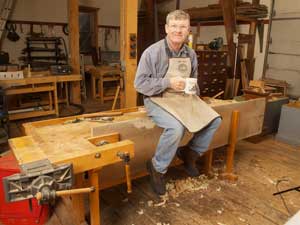
I’m just about done with building my workbench. The top is edge-joined 3/4′ x 3″ x 24″ hardwoods of various species. To finish it, should I use a sanding sealer first and a shellac sealer, or oil, or what? I’m not going to stain it. I would like to have either a high polish oil look or glossy surface. What’s best for a cabinetmaking workbench?
Michael Dresdner: I’ll be happy to tell you how to do a gloss finish on your bench, but that still leaves me wondering why. A workbench, as its name implies, is to work on, and frankly, the best surface to work on is raw wood. It is less slippery, takes all sorts of abuse, and best of all, can be easily cleaned and resurfaced when needed. Still, you asked, so here goes.
You do not need a sealer at all unless one or more of your wood species is a true dalbergia (rosewood, cocobolo, etc.) If that is the case, seal the wood with one coat of de-waxed shellac or Zinsser SealCoat. Otherwise, skip to the next step, which is to apply several coats of oil-based gloss polyurethane. Build the finish until you like the look, and enjoy your workbench. Just promise me you won’t tear your hair out in agony the first time you accidentally drive a chisel into that nice, shiny finish.
Rob Johnstone: A drying oil like Watco is just the ticket. Workbenches get easily scratched, and nothing is easier to touch up than oil. I would also consider a very thin and well-rubbed coat of wax to follow. This just makes cleanup a lot less work and keeps glues from sticking to the surface.





